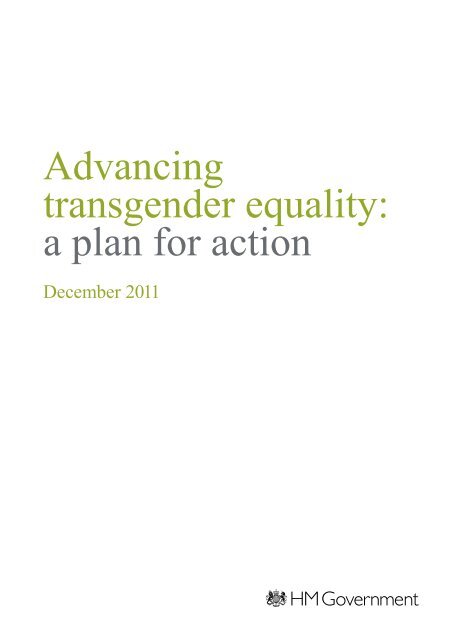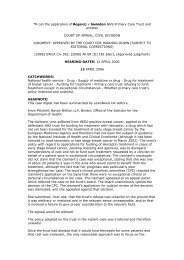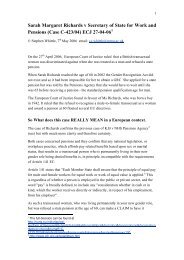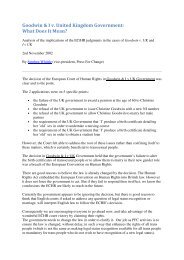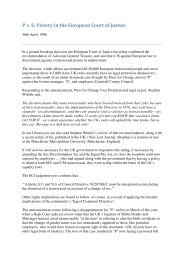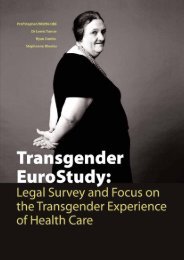Advancing transgender equality: a plan for action
Advancing transgender equality: a plan for action
Advancing transgender equality: a plan for action
You also want an ePaper? Increase the reach of your titles
YUMPU automatically turns print PDFs into web optimized ePapers that Google loves.
<strong>Advancing</strong><strong>transgender</strong> <strong>equality</strong>:a <strong>plan</strong> <strong>for</strong> <strong>action</strong>December 2011
ContentsMinisterial <strong>for</strong>eword................................................................5Section 1: Early years, education andsocial mobility..............................................................................6Section 2: A fair and flexible labour market.............8Section 3: Opening up public services andempowering individuals and communities............... 10Health and social care...................................................11Identity and privacy.........................................................12Civil society..........................................................................13Public sector Equality Duty........................................13Section 4: Changing culture and attitudes............... 14Safety and support.......................................................... 15Equal civil marriage......................................................... 15Promoting rights internationally.............................. 16Making it happen.....................................................................17Glossary....................................................................................... 18
4<strong>Advancing</strong> <strong>transgender</strong> <strong>equality</strong>: a <strong>plan</strong> <strong>for</strong> <strong>action</strong>
5Ministerial <strong>for</strong>ewordLast year the Government published its EqualityStrategy ‘Building a Fairer Britain’. The strategyis built on two principles – equal treatment andequal opportunity. Equality is not just the rightthing to do; it is central to our ambitions to builda better society and a modern economy whichgenuinely draws on the talents of all, whereeveryone feels they can play their part.Transgender people, from transsexual to nongendered,want to be able to participate in andmake their contribution to society and the economy.The Government, employers and public serviceshave a role in enabling this to happen and addressingthe barriers that prevent them from doing so.Prejudice and discrimination not only blight people’slives, they also undermine the principles uponwhich this country prides itself. This Government iscommitted to making <strong>transgender</strong> <strong>equality</strong> a reality.In March 2011, the Government published ‘Working<strong>for</strong> Lesbian, Gay, Bisexual and Transgender Equality:Moving Forward’, which included Government’scommitments to tear down barriers and advanceequal opportunities <strong>for</strong> lesbian, gay, bisexual and<strong>transgender</strong> people in all areas of society – includingin schools, at work and in healthcare.We are already making progress but we arenot stopping there. From barriers to fullparticipation in civil society to tragic incidentsof hate crime, we recognise that <strong>transgender</strong>people can face distinct and specific challengesthat sometimes need to be addressed separately.This first ever Government <strong>transgender</strong> <strong>equality</strong><strong>action</strong> <strong>plan</strong> <strong>for</strong>ms part of our wider work tobuild an equal and fair society. It includes firmcommitments to improve the lives of <strong>transgender</strong>people and support businesses and publicbodies so they have the right tools to support<strong>transgender</strong> people.This document is the culmination of ouractive engagement with the <strong>transgender</strong>community, practitioners and the voluntarysector. It lays out our vision and the focus <strong>for</strong>the Government’s commitment to delivergreater <strong>equality</strong> <strong>for</strong> <strong>transgender</strong> people. Wedo not underestimate the challenges <strong>transgender</strong>people face and the <strong>action</strong>s in this documentare just the first steps towards achieving thisvision. It will take all of us working together tomake this the era where we consign transphobiato the past, and build a strong, modern and fairBritain <strong>for</strong> all.Rt Hon Theresa May MPHome Secretary and Minister <strong>for</strong> Women and EqualitiesLynne Featherstone MPMinister <strong>for</strong> Equalities
6<strong>Advancing</strong> <strong>transgender</strong> <strong>equality</strong>: a <strong>plan</strong> <strong>for</strong> <strong>action</strong>Section 1:Early years, education and social mobilityChildren’s early years have a profound influenceon their life chances. Whilst the experiences of<strong>transgender</strong> 1 pupils are least likely to be reflectedin data and research, 2 we know that over 70 percent of boys and girls who express gender variantbehaviours are subject to bullying in schools. 3Schools should be a safe and supportiveenvironment <strong>for</strong> children to learn in. Tacklingtransphobic bullying helps to addressunacceptable behaviour and ensure that oursociety becomes more tolerant. This Governmentis committed to tackling transphobic bullying andwe want to support schools to act as leaders andadvocates <strong>for</strong> change. We have already issuedanti-bullying guidance to support head teachers intackling all <strong>for</strong>ms of bullying, including transphobicbullying. 4 We are also issuing separate statutoryguidance to extend head teachers’ powers torespond to pupils who bully other pupils outsidethe school premises, and are re<strong>for</strong>ming Ofstedschools’ inspections to give all <strong>for</strong>ms of prejudicebasedbullying more prominence.But there is still a long way to go. We haveidentified a range of commitments to help schoolsbecome more inclusive <strong>for</strong> gender variant childrenand to help provide support and protection to<strong>transgender</strong> pupils in schools. 51 Throughout this document we have used a range ofterms to describe different groups of people, such as<strong>transgender</strong>, transsexual and non-gendered. Theseterms are used <strong>for</strong> the purpose of this document only,to describe those who define themselves in these orother ways. They do not necessarily reflect legal statusand are not intended to be used as definitions <strong>for</strong> anypurpose outside of this document.2 EHRC (2010) Triennial Review.3 EHRC (2009) Research Report 27:Trans Research Review.4 The latest version of this guidance is available onthe following link: https://www.education.gov.uk/publications/eOrderingDownload/DFE-00062-2011.pdf5 Some polices that are set out in this <strong>action</strong> <strong>plan</strong> willapply across the UK or Great Britain, some to Englandand Wales and some to England only, reflecting the factthat the responsibility <strong>for</strong> some of these areas of policyare devolved and others reserved.
7Detailed <strong>action</strong> Start date End date LeadSupport schools with updated, clear andconcise guidance 6 on the implementation ofthe public sector Equality Duty, which includesgender reassignment as one of the protectedcharacteristics.Consider, as part of DfE’s internal review ofpersonal, social, health and economic (PSHE)education, the teaching of <strong>equality</strong> and diversity,including <strong>transgender</strong> <strong>equality</strong>. The review willanalyse the material on <strong>transgender</strong> issuesprovided to them.Work with relevant education and skills sectororganisations and learners to develop a specificproject to raise awareness of the challenges<strong>transgender</strong> people may face.Update and disseminate guidance <strong>for</strong> furthereducation and skills providers and learnerson the LSIS online resource on staff’s legalobligations towards <strong>transgender</strong> people underthe Equality Act 2010 and in<strong>for</strong>mation to<strong>transgender</strong> learners.Ensure that National Citizen Service (NCS) <strong>for</strong>16 year olds is an inclusive and safe environment<strong>for</strong> all participants, including <strong>transgender</strong> people,by encouraging NCS providers to build <strong>equality</strong>issues into their in<strong>for</strong>mation and training <strong>for</strong> staff.September2011July 2011March 2012September2012Department<strong>for</strong> Education(DfE)DfEJanuary 2012 March 2012 Learningand SkillsImprovementService (LSIS)January 2012 March 2012 LSISJanuary 2012 April 2015 Cabinet Office(CO)6 The latest version of this guidance is available on thefollowing link: http://www.education.gov.uk/aboutdfe/policiesandprocedures/<strong>equality</strong>anddiversity/a0064570/the-<strong>equality</strong>-act-2010
8<strong>Advancing</strong> <strong>transgender</strong> <strong>equality</strong>: a <strong>plan</strong> <strong>for</strong> <strong>action</strong>Section 2:A fair and flexible labour marketEquality of opportunity in employment isfundamental to building a strong economy anda fair society. We know that workplaces that aremore inclusive are also more productive.Despite some progress, <strong>transgender</strong> peoplecan still face persistent discrimination in theworkplace. Responses to our survey onemployment 7 indicate that:• Nearly half of <strong>transgender</strong> employeesexperience discrimination or harassment intheir workplaces; 8• 88% of respondents said that ignorance of<strong>transgender</strong> issues was the biggest challengethey faced in employment; 9• Transgender people highlight transitioning atwork as one of the most significant triggers<strong>for</strong> discrimination. 10lesbian, gay, bisexual and <strong>transgender</strong> friendlyworkplaces. This will help employers betteruse the potential of their work<strong>for</strong>ce, including<strong>transgender</strong> employees. We are also updatingadvice <strong>for</strong> employers on recruiting and employing<strong>transgender</strong> employees so they have the rightstools to help them to support their work<strong>for</strong>ce.We have made good progress on thesecommitments and these are on course to becompleted in 2012.However, we want to do more to supportemployers and <strong>transgender</strong> people and haveidentified a number of further commitments.These range from bespoke support and advice tohelp <strong>transgender</strong> people seeking employment toguidance <strong>for</strong> employers on pension entitlement<strong>for</strong> <strong>transgender</strong> employees.This Government is committed to endingdiscrimination in the workplace wherever andwhenever it occurs and is already progressing anumber of projects in this area. As we promisedin ‘Working <strong>for</strong> Lesbian, Gay, Bisexual andTransgender Equality: Moving Forward’, wehave published research on the barriers andopportunities faced by employers in developing7 GEO (2011) Transgender survey #3.414 people responded.8 Transgender survey #3.9 Transgender survey #3.10 EHRC (2010) Triennial Review.
9Detailed <strong>action</strong> Start date End date LeadProvide prospective employers with updatedguidance and targeted support on employing<strong>transgender</strong> people via the Job Centre Plus<strong>transgender</strong> employer support tool. 11 January 2012 Ongoing Job CentrePlusSupport all <strong>transgender</strong> job seekers to findemployment by ensuring revised guidance andtraining are available to Job Centre Plus staff onthe specific challenges <strong>transgender</strong> people mayface in employment.Use new local flexibilities 12 to target preemploymentsupport at individuals with thegreatest needs, including <strong>transgender</strong> people.Update the Department <strong>for</strong> Work and Pensions(DWP) website to clarify state pensionentitlement conditions <strong>for</strong> <strong>transgender</strong> individualswho do not hold a Gender RecognitionCertificate (GRC).Set up a temporary dedicated team to handlepension claims from those affected by recentjudgments on the implications of people’s genderreassignment <strong>for</strong> state pension purposes.Improve DirectGov and HMRC guidance <strong>for</strong>employers and customers on the implications ofgender reassignment <strong>for</strong> tax purposes.January 2012 Ongoing Job CentrePlusJanuary 2012 Ongoing Job CentrePlusJanuary 2012November2011January 2012December2012April 2012December2012DWPDWPHer Majesty’sRevenue andCustoms(HMRC)11 The Job Centre Plus <strong>transgender</strong> employer supporttool is a resource which includes in<strong>for</strong>mation and advice<strong>for</strong> employers on employing <strong>transgender</strong> employees.Other tools are available to cover issues e.g. flexibleworking.12 This would include, <strong>for</strong> example, referral to training,using existing funding available.
10<strong>Advancing</strong> <strong>transgender</strong> <strong>equality</strong>: a <strong>plan</strong> <strong>for</strong> <strong>action</strong>Section 3:Opening up public services and empoweringindividuals and communitiesLike everyone else, <strong>transgender</strong> people have the rightto expect that their needs are considered and, wherepossible, met by public services. The Equality Act 2010includes a public sector Equality Duty which requirespublic bodies, when exercising their functions, to havedue regard to the need to eliminate discrimination,advance <strong>equality</strong> of opportunity, and foster goodrelations between people with different protectedcharacteristics. This includes gender reassignment.Responses to our surveys 13 indicate that<strong>transgender</strong> people face persistent challenges inaccessing public services:• More than half of respondents said they suffereddiscrimination in accessing public services becauseof their <strong>transgender</strong> status; 14• More than half of respondents said health wastheir most significant area of concern; 15• Two thirds of respondents said they hadexperienced threats to their privacy (e.g. havingone’s gender identity revealed at work withoutconsent). 16We have already started work on these issues,including supporting public bodies to deliver<strong>equality</strong> <strong>for</strong> everyone, including <strong>transgender</strong>people. As we committed in ‘Working <strong>for</strong>Lesbian, Gay, Bisexual and Transgender Equality:Moving Forward’, we will shortly be publishing an‘Accountability & Transparency Support Package’to help the voluntary, community and socialenterprise sector and the public use the publicsector Equality Duty in holding public bodiesto account. But more needs to be done. Thefollowing commitments aim to address some ofthe concerns highlighted during our discussionswith <strong>transgender</strong> people.13 Please note that the three online trans surveysconducted by GEO are not census of the <strong>transgender</strong>population. These surveys have been carried out to tryto understand the main areas of concern <strong>for</strong> <strong>transgender</strong>people, and there<strong>for</strong>e results should not be used toderive population estimates or other demographicin<strong>for</strong>mation related to the <strong>transgender</strong> community.14 GEO (2011) Transgender survey #1.1275 people responded.15 Transgender survey #1. 16 Transgender survey #3.
11Health and social careDetailed <strong>action</strong> Start date End date LeadThrough the NHS Equality Delivery System,support NHS commissioners and providers’compliance with the public sector Equality Dutyand ensure that decisions are fair, transparent,accountable, evidence-based and consider theneeds and rights of staff and patients across allthe protected characteristics, including genderreassignment.Commission and publish a clear and conciseguide <strong>for</strong> health practitioners, including GPsand Primary Care Trusts, and the <strong>transgender</strong>community on care pathways and availabletreatments. This includes in<strong>for</strong>mation on thehealth of <strong>transgender</strong> young people and generalhealthcare issues post transition.Update the NHS Choices website and addin<strong>for</strong>mation on <strong>transgender</strong> health, includingsexual health and links to other useful websites.Lead a dialogue between the <strong>transgender</strong>community, including non-gendered people, themedical profession and NHS commissioners, toshare best practice and review how this groupcan shape health policy.Take active measures to ensure that the views of<strong>transgender</strong> users shape the Government's Careand Support White Paper and create a caremarket that is more responsive to diverse needs.As part of the Government’s wider work onreducing waiting times in accessing mental healthservices, review the issue of delays experiencedby patients undergoing gender dysphoriatreatment.As part of the Government’s wider work todevelop a new NHS Commissioning System,ensure greater consistency in commissioninggender identity services, increased patient choiceand more cost effective treatment <strong>plan</strong>s <strong>for</strong>gender dysphoria.July 2011 February 2012 Departmentof Health(DH)January 2012 April 2013 DHDecember2011December2012DHJuly 2011 Ongoing DHSeptember2011December2011November2011December2012December2012April 2013DHDHDH
12<strong>Advancing</strong> <strong>transgender</strong> <strong>equality</strong>: a <strong>plan</strong> <strong>for</strong> <strong>action</strong>Health and social care (continued)Detailed <strong>action</strong> Start date End date LeadAs part of the Government’s wider work ondeveloping a new national suicide preventionstrategy, consider whether the <strong>transgender</strong>community would benefit from specificinterventions.Ensure that public health programmes consultwidely with <strong>transgender</strong> people and whereappropriate, include consideration of<strong>transgender</strong> health.March 2011 March 2012 DHDecember2011OngoingDHIdentity and privacyDetailed <strong>action</strong> Start date End date LeadReview how gender identification is representedin passport application <strong>for</strong>ms and passports.Deliver a framework <strong>for</strong> evaluating the EqualityAct, including the implementation of theexceptions on gender reassignment.Include in employment and services guidancein<strong>for</strong>mation on the appropriate application of theGender Recognition Act 2004 and use of gendermarkers to help protect <strong>transgender</strong> employees’privacy.Update in<strong>for</strong>mation on the GEO and theIn<strong>for</strong>mation Commissioner’s Office’s (ICO)websites <strong>for</strong> the <strong>transgender</strong> community onpreserving <strong>transgender</strong> people’s privacy inemployment and services under the DataProtection Act 1988, the Human Rights Act1998 and the Gender Recognition Act 2004.Publish a package of in<strong>for</strong>mation <strong>for</strong> <strong>transgender</strong>people, outlining where legislation and policy canprovide them with support to tackle the issuesthey may face.January 2012 February 2013 Identity andPassportService (IPS)October 2010 October 2015 GovernmentEqualitiesOffice (GEO)March 2012 March 2013 GEOJanuary 2012December2012GEOICOJanuary 2012 March 2013 GEO
13Civil societyDetailed <strong>action</strong> Start date End date LeadRun a workshop <strong>for</strong> the <strong>transgender</strong> communitywith Parliamentary Outreach to increase<strong>transgender</strong> people’s understanding of howParliament and central Government work andthe best way to engage with them.Signpost, via digital media, relevant opportunitiesto young <strong>transgender</strong> people on participating ingovernment funded programmes and make surethat those providing these programmes makethem open to everyone.As part of wider work on encouraging peopleto participate in public and political life, promoterelevant opportunities to <strong>transgender</strong> peopleso, if they wish, they can act as role models <strong>for</strong>others to participate.Promote, via government in<strong>for</strong>mation portals,relevant funding streams to the <strong>transgender</strong>community to ensure they are aware of fundingavailable to participate in the localism agenda.Signpost, on relevant digital media, opportunities<strong>for</strong> <strong>transgender</strong> women to engage with work onstrengthening women’s voices in Government.January 2012December2011November2011December2011December2012December2012December2012OngoingGEOGEOCOGEOGEOCOJune 2011 Ongoing GEOPublic sector Equality DutyDetailed <strong>action</strong> Start date End date LeadRun a workshop <strong>for</strong> the <strong>transgender</strong> communityto increase their understanding of the publicsector Equality Duty and how they can holdpublic bodies to account.January 2012 January 2013 GEO
14<strong>Advancing</strong> <strong>transgender</strong> <strong>equality</strong>: a <strong>plan</strong> <strong>for</strong> <strong>action</strong>Section 4:Changing culture and attitudesAttitudes are changing and today we are a morediverse and fairer society. However, too many<strong>transgender</strong> people face discrimination or evenviolence because of who they are:• Between 2009 and 2010, there has been a 14%increase in <strong>transgender</strong> related hate crime –going up from 312 incidents to 357 incidents; 17• In only two EU member states, gender identityor transphobic hate crime are explicitlyaddressed in hate crime legislation. 18While the level of hate crimes recorded by thepolice may reflect the confidence that victimshave in reporting to the police, and the measureswe are taking to improve confidence andreporting, victims groups tell us that this is stillgreatly under-reported. We need to do more totackle prejudice and violence against <strong>transgender</strong>people. Good progress has been made to addressthese issues. Key achievements include:• A module on issues surrounding asylum claimsbrought on the grounds of the applicant’sgender identity has now been included in allfoundation and consolidation training to asylumdecision makers;• 30 sports bodies and over 2000 individualshave already signed up to our Charter againsthomophobia and transphobia in sport;• The UK played an active role in the adoptionof the UN Human Rights Council historicresolution expressing grave concern aboutacts of violence and discrimination againstindividuals because of their sexual orientationand gender identity.But we need to do much more to make<strong>transgender</strong> <strong>equality</strong> a reality. The following <strong>action</strong>saim to deliver further progress on this agenda.• From April this year, police <strong>for</strong>ces have beenrequired to collect data on transphobic hatecrime which will be published next year asofficial statistics;17 Association of Chief Police Officers (ACPO) figures,released on 8 September 2011.18 European Union Agency <strong>for</strong> Fundamental Rights (2010)‘Homophobia, Transphobia and Discrimination onGrounds of Sexual Orientation and Gender Identity:2010 Update – Comparative Legal Analysis’.
15Safety and supportDetailed <strong>action</strong> Start date End date LeadLegislationIntroduce an amendment to the Legal Aid,Sentencing and Punishment of Offenders Billto amend section 146 and Schedule 21 of theCriminal Justice Act 2003. This will provide<strong>for</strong> sentences to be aggravated <strong>for</strong> any offencemotivated by hostility towards the victim onthe grounds of being <strong>transgender</strong>, and <strong>for</strong> a30 year starting point <strong>for</strong> murders motivatedby hostility towards the victim on the groundsof being <strong>transgender</strong>.Develop and publish a new cross-governmenthate crime <strong>action</strong> <strong>plan</strong>, which will includeproposals <strong>for</strong> addressing transphobic hate crime.HousingWork closely with the Chartered Institute ofHousing to raise awareness of new good practiceguidance 19 with housing providers on the specificaccommodation needs of <strong>transgender</strong> peopleand the distinct challenges they face, includinganti social behaviour and hate crime.TransportConduct a review with the pan-industryPassenger Transport Executive (PTE) Safetyand Security Group to identify <strong>action</strong>s to tackletransphobic hate crime on transport.December2011November2011January 2012March 2012MoJHOMoJJanuary 2011 March 2012 Department<strong>for</strong>Communitiesand LocalGovernment(DCLG)January 2012 January 2013 Department<strong>for</strong> Transport(DfT)Equal civil marriageDetailed <strong>action</strong> Start date End date LeadWork with the <strong>transgender</strong> community toensure that everyone with an interest has theopportunity contribute to Government's workon equal civil marriage and that their needs areconsidered as part of this work.October 2011 June 2012 GEO19 This guidance can be purchased online: http://www.cih.org/publication/display/vpathDCR/templatedata/cih/publication/data/Delivering_housing_services_to_LGBT_customers
16<strong>Advancing</strong> <strong>transgender</strong> <strong>equality</strong>: a <strong>plan</strong> <strong>for</strong> <strong>action</strong>Promoting rights internationallyDetailed <strong>action</strong> Start date End date LeadEurope and worldwideInclude a <strong>for</strong>mal objective on progressing LGB&T<strong>equality</strong> in the UK chairmanship of the Council ofEurope and ensure real progress is delivered onthis agenda.Building on the recent adoption of the UNHuman Rights Council resolution in June 2011,play an active role in ensuring constructive,in<strong>for</strong>med and transparent dialogue on the issueof discriminatory laws and practices and acts ofviolence against individuals based on their sexualorientation and gender identity.ImmigrationImprove guidance <strong>for</strong> immigration caseworkerson handling in-country applications fromtranssexual applicants.Signpost on UKBA intranet asylum caseownersto guidance on gender identity issues in theasylum claim, with a particular focus on types ofpersecution and difficulties that a <strong>transgender</strong>applicant might have experienced.Engage with the <strong>transgender</strong> communityand other partners to ensure that, wherepossible, up to date in<strong>for</strong>mation on thesituation of <strong>transgender</strong> people is accuratelyreflected in Country of Origin In<strong>for</strong>mation(COI) Service’s products.November2011May 2012June 2011 Ongoing GEOFCOGEOForeign &CommonwealthOffice(FCO)April 2011 March 2012 UK BorderAgency(UKBA)June 2011 Ongoing UKBAJune 2011 Ongoing UKBA
17Making it happenThe <strong>transgender</strong> <strong>equality</strong> <strong>action</strong> <strong>plan</strong>demonstrates the cross-Governmentapproach and commitment towards improving<strong>equality</strong> <strong>for</strong> <strong>transgender</strong> people in all aspectsof their lives. Together with Working <strong>for</strong>Lesbian, Gay, Bisexual and Transgender:Moving Forward, these documents set out theframework <strong>for</strong> Government to act as a leaderand catalyst <strong>for</strong> change, taking the first steps toadvance <strong>transgender</strong> <strong>equality</strong>, both domesticallyand internationally.Only if we work together will we achieve thefairer, more equal and more prosperous societythat we all want to see.In line with the Government’s commitmentto transparency and accountability, we arecommitted to do two things:• We will work with and support public bodies,businesses, practitioners and the voluntarysector throughout the delivery of thecommitments included in this <strong>action</strong> <strong>plan</strong>.• In ‘Working <strong>for</strong> Lesbian, Gay, Bisexual andTransgender: Moving Forward’ we committedto launching a Call <strong>for</strong> Evidence (CfE) in2012. This will also include a CfE on the<strong>action</strong>s which are included in the <strong>transgender</strong><strong>equality</strong> <strong>action</strong> <strong>plan</strong>. This will allow anyonewith an interest in <strong>transgender</strong> <strong>equality</strong> tolet Government know their views and insightson the delivery of each section, how theymay be implemented differently, or moreeffectively. We anticipate that the CfE willlast <strong>for</strong> three months.
18<strong>Advancing</strong> <strong>transgender</strong> <strong>equality</strong>: a <strong>plan</strong> <strong>for</strong> <strong>action</strong>GlossaryACPOBISCODCLGDfEDHDWPEHRCFCOGEOHMRCHOIPSICOLSISMoJSFAUKBAAssociation of Chief Police OfficersDepartment of Business Innovation and SkillsCabinet OfficeDepartment <strong>for</strong> Communities and Local GovernmentDepartment <strong>for</strong> EducationDepartment of HealthDepartment <strong>for</strong> Work and PensionsEquality and Human Rights CommissionForeign and Commonwealth OfficeGovernment Equalities OfficeHer Majesty’s Revenue and CustomsHome OfficeIdentity and Passport ServiceIn<strong>for</strong>mation Commissioner’s OfficeLearning and Skills Improvement ServiceMinistry of JusticeSkills Funding AgencyUK Border Agency
ISBN: 978-1-84987-603-2© Crown copyright 2011You may re-use this in<strong>for</strong>mation (notincluding logos) free of charge in any <strong>for</strong>mator medium, under the terms of the OpenGovernment Licence.To view this licence, visit www.nationalarchives.gov.uk/doc/open-government-licence/or write to the In<strong>for</strong>mation Policy Team,The National Archives, Kew, London TW9 4DU,or e-mail: psi@nationalarchives.gsi.gov.uk.This publication is available <strong>for</strong> download atwww.homeoffice.gov.uk/equalities/.


